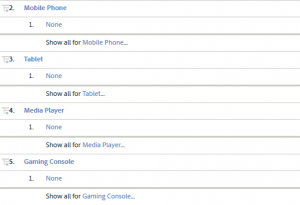I was surprised to find that Adobe Analytics (Adobe SiteCatalyst or Omniture, depending on how far back you go) doesn’t allow you to report on mobile browsers. Even though, I’ve been using Adobe SiteCatalyst for many years and I had always assumed that the ability was there. I am actually a little ashamed that I hadn’t noticed this before.

The main reason for me to look at this was that a colleague sent me a link about Embedded Mobile Browser Usage on http://www.lukew.com. While the blog post is more to do with how developers should be testing on in-app versions of mobile browsers as well as native browsers. This is mainly due to the in-app versions of Safari and the native Android browsers having less functionality and lower rendering powers. Luke explains that the in-app version of Safari for example does not include the Nero Javascript engine, certain Safari caches, or the “asynchronous” rendering mode. Meaning that web sites could appear to load more slowly, contain errors etc that would normally not be detected if testing on the native versions.
As Facebook and Twitter app usage continues to grow, its going to become more and more important to understand the differences between these different browser types and how users browse your sites when using these apps. In addition, when users click on your content from apps such as Facebook and Twitter, they appear as either Direct or Typed/Bookmarked depending on which analytics package you use and whether you are using any form of campaign tracking or not.
When I realised that Adobe Analytics does not track mobile device browsers, I turned to our implementation of Google Analytics. Fortunately, GA does track in-app browsers on iOS – so you can see data for Safari and Safari (in-app).
What I have found in my initial dive into this is that users browsing our sites using an in-app verison of the native browser consume less content (in terms of pages per visit), has a higher bounce rate and are on the site for about half the time than the native version.

What is going to be hard to work out is whether this is due to a behavioural or technical motivation.
If the site renders slowly, contains certain errors, or is not fully optimsied for the in-app experience, you could attribute some of the reduction of usage to this rationale.
In terms of behavioural, you need to consider what users are doing. If I am on my Facebook app on my phone, its probably while I am in the middle of doing something else. Potentially on the toilet, in a meeting (hopefully my boss is not reading this) or in transit therefore I have limited time to view.
Also, to move this point further, if I am in my Facebook app, I’m also interested in seeing what other content my friends have posted. So I might just read the article that a friend posted, then click back in the app so I go back to my feed and continue my Facebook journey.
One of the main things that I tell colleagues at my job is that Analytics is great at telling you what happened. Trying to find the reasons behind a person’s behaviour is not generally achievable. You can find commonalities between certain types of users, segment them and try to implement changes to convert users to behave in the same way. But in terms of understanding the drivers for users to act in a particlular way is not something that I believe Analytics will answer.
You need to be talking to your users and understanding why they are doing what they are doing – whether it be done through social media, email or surveys. You really need to have all the information to make decisions and I believe that Analytics is only one part of it in this case.
